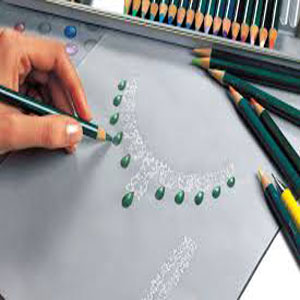Inframe Design Institute located in jodhpur, Jaipur, Ajmer, Pali, Naguar, Jaisalmer, Kota, Ahmedabad, Delhi. Inframe Design Institute offer courses in Fashion Design, Interior Design, Textile Design, Product Design, Graphics Design,Animation Design, Web Design, Jewellery Design. Inframe Design also offers coaching for numerous design field competitive examinations like NIFT, NID, UCEED, CEED, NATA, JEE (B Arch.), CEPT, PEARL, FDDI, IICD, VGU, Sushant and also we offer some short duration design courses like Autocad, 3dsMax, Revit, Sketchup etc.
Jewellery (British English) or jewelry (American English) consists of small decorative items worn for personal adornment, such as brooches, rings, necklaces, earrings, pendants, bracelets, and cufflinks. Jewellery may be attached to the body or the clothes, and the term is restricted to durable ornaments, excluding flowers for example. For many centuries metal, often combined with gemstones, has been the normal material for jewellery, but other materials such as shells and other plant materials may be used.

Jewellery may be made from a wide range of materials. Gemstones and similar materials such as amber and coral, precious metals, beads, and shells have been widely used, and enamel has often been important. In most cultures jewellery can be understood as a status symbol, for its material properties, its patterns, or for meaningful symbols. Jewellery has been made to adorn nearly every body part, from hairpins to toe rings, and even genital jewellery.
Jewellery design is the art or profession of designing and creating jewellery. This is one of civilization's earliest forms of decoration, dating back at least seven thousand years to the oldest known human societies in Mesopotamia and Egypt. The art has taken many forms throughout the centuries, from the simple beadwork of ancient times to the sophisticated metalworking and gem cutting known in the modern day.

Jewellery design has remained relatively constant over the years. The fundamental references, production techniques, and materials from ages ago are still being used to this day. Yet the recent rapid developments in technology and machinery have allowed artists easier alternatives to some of the old methods. These advancements have also transformed the significance and social weight jewellery holds.The twentieth century is where this rudimentary change in the public's attitude towards jewellery design and function is most apparent. Traditionally jewels were seen as sacred and precious; however, notably beginning in the 1900s, jewellery has started to be objectified. Additionally, no one trend can be seen as the history of jewellery design for this time period. Throughout the twentieth century jewellery design underwent drastic and continual style changes: Art Nouveau (1900–1918), Art Deco (1919–1929), International Style & organicism (1929–1946), New Look & Pop (1947–1967), Globalization, Materialism, and Minimalism. Jewellery design trends are highly affected by the economic and social states of the time. The boundaries of styles and trends tend to blur together and the clear stylistic divisions of the past are harder to see during the twentieth century.
14 Jewellery Design Courses in Rajasthan Offering 50 Courses
Courses in Jewellery Design
- B.Sc.(Jewellery Design)
- B.Sc.(Jewellery Design and Technology)
- Advanced Diploma in Jewellery Design
- Graduate Diploma in Jewellery Designing(GDJD)
- Graduate Diploma in Jewellery Designing Manufacturing(GDJDM)
